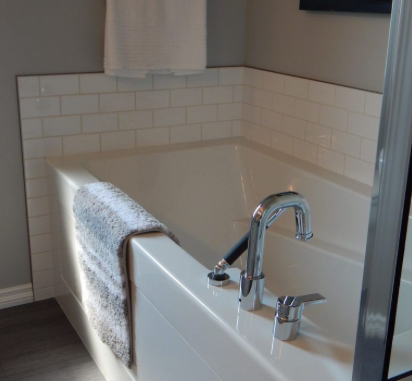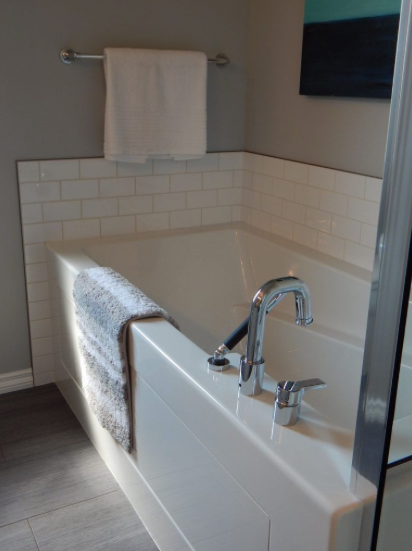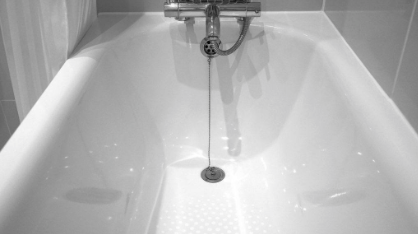
Contributed by TheHandyNest.com
A dirty and filthy bathtub with spots and scratches is hardly a relaxing sight. It can also act as a breeding ground for germs and bacteria. Here we will be talking about some of the best ways on how to clean bathtub and how to protect it from dirt and spots.
Materials Used To Create A Bathtub
Depending on the material that is used to create the bathtub, different methods of cleaning can have different effects on the bathtub. Some of the materials are easier to clean when compared to others, whereas some might take longer and more effort. Let’s have a quick look on a few materials that are commonly used to make bathtubs.
Porcelain Enameled Steel Bathtub
 Porcelain enameled steel is a commonly used and comparatively inexpensive option when it comes to making bathtubs. These bathtubs tend to be heavier than acrylic and fiberglass bathtubs. They are extremely durable and are easy to clean.
Porcelain enameled steel is a commonly used and comparatively inexpensive option when it comes to making bathtubs. These bathtubs tend to be heavier than acrylic and fiberglass bathtubs. They are extremely durable and are easy to clean.
Some of the disadvantages of using a porcelain enameled steel bathtub are that they tend to get chipped easily and these chipped areas can quickly begin to rust.
Cleaning tips:
When cleaning a porcelain bathtub, avoid using abrasive cleaners as they can chip the surface of the bathtub. Also stay away from scouring powder, white vinegar, and steel wool as they can damage the finish of the bathtub.
If you are looking for a cleaner that is gentle on the surface and can be used weekly, then you can choose any of the bathtub cleaners available in the store. Be sure to check if the given cleaner is safe on porcelain enamel.
You can even make your own porcelain bathtub cleaner at your home by following the below steps:
- Add a couple tablespoons of your dish washing soap to a gallon of hot water and apply on the surface of the bathtub using a sponge or a rag.
- Scrub the porcelain and rinse well with water.
Make sure you only use this process once a month — at most — as it can damage the bathtub with overuse. If you wish to give your bathtub a new and shiny appearance, dab a small amount of lemon oil and rub the sides of the bathtub.
Acrylic Bathtub
 Acrylic bathtubs are often used today due to their versatility, durability, options, and economic affordability. The acrylic tub is made up of vacuum formed acrylic sheets, which are then reinforced with the help of fiberglass. They have a non-porous surface and can be repaired to some extent in the case of any damage. They come exclusively in a range of colors, shapes, and sizes.
Acrylic bathtubs are often used today due to their versatility, durability, options, and economic affordability. The acrylic tub is made up of vacuum formed acrylic sheets, which are then reinforced with the help of fiberglass. They have a non-porous surface and can be repaired to some extent in the case of any damage. They come exclusively in a range of colors, shapes, and sizes.
But care should be taken while cleaning such bathtubs as they easily tend to get scratched when cleaned with an abrasive cleaner.
Cleaning tips:
It is extremely important to be careful when cleaning your bathtub if it is made up of acrylic plastic. Acylic plastic can be easily damaged by the effects of chemical and abrasive materials. So, it is highly recommended to take all the more care while cleaning an acrylic plastic bathtub. Here is what you can do:
- Use warm water and wet the bathtub before you begin the cleaning process.
- Pour a small amount of baby shampoo on a damp rag or a piece of cloth and rub the surface of the bathtub in circles.
- Rinse the rag often as the rag can begin to accumulate soap on it. Rinse the surface of the bathtub and repeat the process until you think that the bathtub is clean and spot free.
- After the surface has dried and is cleaned, use a can of car wax and a rag to apply the wax on the surface of the bathtub.
- Apply the wax on the surface of the bathtub in circles, like how you would generally apply car wax on your car.
- Allow the surface to dry out for a few minutes and buff the surface of the bathtub with the help of a dry cotton ball.
The car wax applied on the bathtub makes the soap, water, and shampoo do not stick to the surface. Repeat the process if necessary.
Fiberglass Bathtub
 Fiberglass bathtubs are another affordable option when it comes to bathtubs. They are created with layers of surface coat, polyester resin, and fiberglass reinforcements. They are less durable as well.
Fiberglass bathtubs are another affordable option when it comes to bathtubs. They are created with layers of surface coat, polyester resin, and fiberglass reinforcements. They are less durable as well.
You should take care when you are cleaning your fiberglass bathtub as they are not durable like other materials and the surface can easily get cracked and scratched. The finish also tends to fade away with constant use.
Cleaning tips:
You can clean your fiberglass bathtub with the help of a shower or cleaner mixture as explained in the steps below:
- In a part of hot water, mix a healthy amount of baking soda and half a cup of your dish soap.
- When the components are mixed, it will begin to form a paste.
- Keep adding baking soda to the mixture till it is able to stick on the wall of the bathtub.
- Use a sponge and apply the mixture on the bathtub and allow it to stand for 30 minutes or more.
- After half an hour, wait and scrub the bathtub vigorously.
- Rinse the fiberglass bathtub with the help of cold water and wipe away the excess water with the help of a paper towel.
- Now you can use a magic eraser to wipe away all the stains and dirt once again.
To give your fiberglass bathtub the shine and appearance of a new bathtub, use a good grade rubbing wax that is made especially for fiberglass. Here is what you need to do:
- Take a good grade auto wax and an orbital buffer.
- Apply the rubbing wax and work your magic in small sections.
- Don’t apply the mixture for long on one area as it can burn the fiberglass.
- Buff the rubbing wax with the help of a terry cloth and complete the process with the help of auto wax.
- Rinse with cold water to harden and allow the shine to stay for longer.
Enameled Cast Iron Bathtub
 An enameled cast iron bathtub is an extremely durable and heavy bathtub, which is made up of enameled cast iron. It is made up of molded iron and is coated with enamel. It is more expensive when compared to the other kinds of bathtubs but this makes them all the more durable and long lasting.
An enameled cast iron bathtub is an extremely durable and heavy bathtub, which is made up of enameled cast iron. It is made up of molded iron and is coated with enamel. It is more expensive when compared to the other kinds of bathtubs but this makes them all the more durable and long lasting.
The thick enamel cover makes it resistant to chipping and scratching and helps you maintain the look for years to come. However, avoid using harmful chemicals on an enameled cast iron bathtub, and use baking soda and water to keep it new for years to come.
Cleaning tips:
Handle an enameled cast iron with caution as you can end up discoloring it with the use of harmful chemicals. For daily cleaning, it is highly recommended to use baking soda with warm water. All you need to do is:
- Make a paste out of baking soda and warm water and apply it on the stains
- Let the paste sit there for around 30 minutes
- Use a cleaning towel to scrub the scrum and filth
- Rinse with warm water.
However, if your bathtub has some tough stains, follow the following steps:
- Mix a teaspoon of trisodium phosphate cleaner (TSP) with hot water.
- Apply the solution on the stain with gentle rubbing using a sponge and rinse well.
Bathtubs Made of Cast Polymers (Like Cultured Marble, Granite or Onyx)
 These are special engineered natural stone or solid surface materials that are molded together with minerals, polymeric materials, and resins to form a solid surface, and are usually finished off with a gel cast finish.
These are special engineered natural stone or solid surface materials that are molded together with minerals, polymeric materials, and resins to form a solid surface, and are usually finished off with a gel cast finish.
Proper care should be taken while cleaning cast polymer bathtubs as even the slightest scratches can destroy the shine of the bathtub. It is thus highly recommended to avoid using abrasive scrubs and chemicals on it.
Cleaning tips:
It is important to adopt proper steps while cleaning a cast polymer as even the slightest scratches would be easily visible. It is highly recommended to avoid using abrasive cleaners and scratchy sponges. Follow the following steps to stay safe:
- Use a mild detergent or a mild soap for cleaning.
- In order to remove soap scrums, mix vinegar and water in equal amounts and spray on the affected area.
- Wipe the area with a soft cloth.
Things To Avoid When Cleaning Your Bathtub
By avoiding some of these common and silly mistake and errors that people often do, you can make sure that your bathtub shines and keeps shining for a longer duration.
- Don’t leave your soap or shampoo bottles on the bathroom or bathtub floor as this can cause more stains and marks to emerge. The acids in these products make the bathtub easier to crack and for the bacteria to grow.
- Never use any abrasive scrub pads, hard tools, or steel wool to rub or scrub the surface of the bathtub. This can cause the bathtub to crack and start showing marks and scratches.
- Stay away from products that are too hard for the bathtub. Stay away from paint thinners as they have the same effect of an abrasive scrub pad or steel wool on the bathtub.
- Don’t work with chemicals without any form of ventilation. The ventilation can be in the form of a window or an exhaust fan. Working in enclosed situations with these chemicals can cause fumes that can be harmful to the lungs and the skin of the user.
- Don’t have all your hopes on one product. Use the products that are most suited for the area and the work.
- It is important to let the disinfectant sit on the surface of the bathtub for at least 5 minutes.
- Don’t just clean the dirty area. Many of us think that it is enough to clean the dirt and stain from the visible area or in the areas that have the stain. Nothing could be further from the truth. Clean the whole bathtub and bathroom for a clean and germ-free environment. Clean the sides, hidden areas, inside the structure and all around to make sure that your bathtub is free of any stains and bacteria.
- Trim your shower curtain to match your bathtub. When the shower liner hits the bathtub, the area is too wide and can act as an easy breeding ground for mold and mildew.
View the full bathtub cleaning guide at TheHandyNest.com.
This post originally appeared at TheHandyNest.com. Reprinted with permissions. Copyright 2017.





